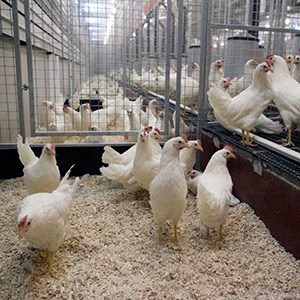Facts:
The project runs 2022-2025 and is financed by Formas.

The aim of the project is to evaluate alternative litter materials and feed compositions as strategies to reduce ammonia levels in poultry houses.
More and more hens in Sweden are housed in different floor housing systems. In these systems the availability of a large littered area increases the possibilities for the hen to perform different behaviours. However, the littered area also brings disadvantages in the form of higher levels of ammonia and dust in the air. During the production cycle manure accumulates in the litter bedding, and nitrogen in the manure is converted by bacteria into ammonia. The aim of this project is to evaluate alternative litter materials and feed compositions as two possible strategies to reduce ammonia levels in poultry houses.
Ammonia is a gas that can cause respiratory damage to both poultry and keepers, and therefore ammonia levels in poultry houses should not exceed 10 ppm. Meeting the limit is a major challenge for many egg producers, particularly during the winter months. The greatest degradation of nitrogen to ammonia occurs when the litter has a high pH, is reasonably moist, the temperature is high and the hen's manure is high in nitrogen.
Peat and biochar both have good ammonia binding capacity, but dust and increased risk of dirty eggs are considered as risks. The project will therefore start with a study evaluating different sources of biochar and peat regarding their tendencies to dust and their ability to bind ammonia and moisture. The most promising biochar and peat varieties will then be evaluated as litter materials in a laying hen study. The comparison also includes wood shavings with or without the regular distribution of a complex of microorganism. The idea is that the microorganisms, by producing organic acids, lower the pH of the litter while converting some of the nitrogen into microbial, more stable protein. This impairs the conditions for the bacteria that convert nitrogen to ammonia.
Overfeeding of protein leads to more nitrogen in the poultry manure, and more nitrogen available for conversion to ammonia. On the other hand, more fibre in the feed can favour bacteria that produce organic acids that lower the pH, and convert nitrogen into microbial protein. In an experiment with laying hens, we are evaluating if a reduced protein content of the hen's feed in combination with a high-fibre roughage can reduce the emission of ammonia from the litter.
In addition to ammonia, microorganisms present in the litter and in the hens’ intestines will be analysed. The well-being of the hens is evaluated in behavioural studies and by scoring their feather cover and cleanliness of plumage and feet. Egg production and exterior egg quality (cracks and dirties) are also recorded. Overall, this provides a good basis for assessing the impact of different litter materials and feeding strategies on ammonia emission from litter beddings, animal welfare and production performance.
Helena Wall (HUV), helena.wall@slu.se
Emma Ivarsson (Department of Animal Nutrition and Management), Kristina Mjöfors (RISE Research Institutes of Sweden AB), Lena Rodhe (RISE Research Institutes of Sweden AB), Malin Alm (Vreta Kluster AB), Li Sun (Department of Animal Nutrition and Management)
The project runs 2022-2025 and is financed by Formas.